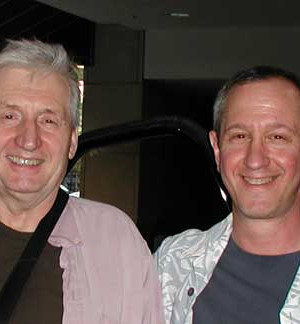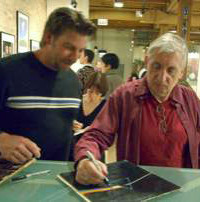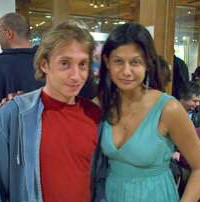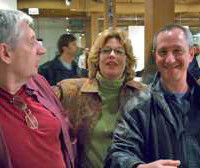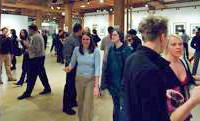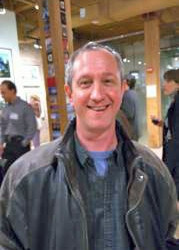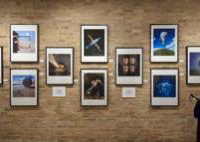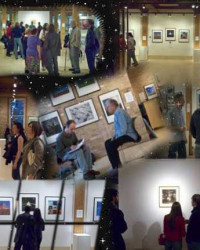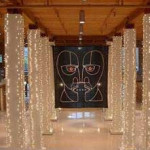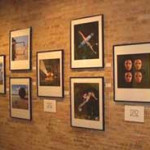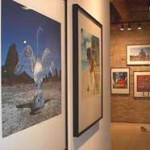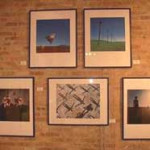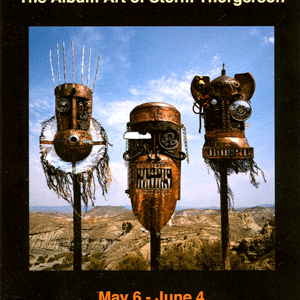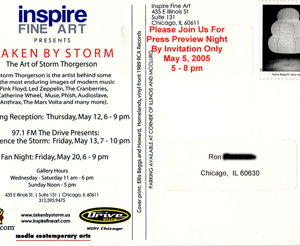Taken by Ron
A Conversation with Storm Thorgerson
by Ron Fleischer (aka RonToon)
A few weeks back I was contacted by Colin, creator, curator, and owner of A Fleeting Glimpse, who asked me one of the most rhetorical questions I had ever heard. Would I like press credentials for Storm’s Chicago exhibit? Of course I jumped at the chance, and Col hooked me up with Robin, from Media Bitch, the company managing and promoting Storm’s tour. She not only obliged in getting me everything I needed, but also supplied passes for the Columbia Chronicle, Columbia College’s newspaper (where I work at my full-time gig).

Nina From Media Bitch
The turn-out for the press preview on the 5th was a bit small, but it gave me the opportunity to meet Nina, who had flown in from the U.K., tag-teaming Robin, who had headed back home. Nina showed me around the gallery and we exchanged knowledge of all of Storm’s work. I wanted to take a few pictures, but found that the batteries in my camera were dead. I ran across the street to get some new ones, but found that my memory card was missing as well. Shit! Oh well, there would still be other opportunities ahead.
The prints that are being exhibited and sold are to die for. The quality and color is amazing, and you can see every fine detail in these extra large prints. The specifics of these images have been discussed before, so I won’t repeat any old info…. but if you can afford any of these, I would grab them up as soon as possible!
We arrived at O’Hare to pick everyone up, albeit a bit late (I still have no control over woman), and were promptly scolded for being so (and yes, it is pretty cool to be yelled at by Storm). Joining Storm was his son Bill (who works with his father as well), and Rupert Truman (a brilliant photographer who has worked with Storm on several projects including shooting the “The Division Bell” and “Echoes:TBoPF” covers).
Later on, when I heard Nina discussing Storm’s arrival on the following Tuesday, I was surprised to learn that she was planning to hop a train to O’Hare and take a cab back to the city with Storm and company. Without hesitation I offered my services, having a nice size mini van with a removed middle seat section, practically making it a stretch limo. Nina checked to see if this was okay with Storm, who seemed to be flattered by the gesture.
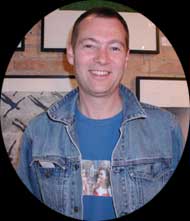
Rupert Truman
The ride back to the city was like being in a slow moving parking lot, but it gave me a chance to answer some of Storm’s questions regarding Amtrak (which they’re taking to the west coast), where to buy a very expensive camera, the Frank Lloyd Wright district, and some of the downtown landmarks. We also discussed a bit of politics, and soon found myself explaining the meaning of the red and blue states.
I dropped them all off at the gallery, and Storm asked if could wait a while why he checked things out inside, and then take them to the hotel. After all the hours I spent waiting for Floyd tickets in my life, I supposed I could do this standing on my head and holding my breath. No problem.
They all emerged from the gallery about an hour later, and Storm handed me a signed copy of his Pink Floyd postcard set which he signed, “To Ron. Thanks for the ride! Storm Thorgerson.” I profusely thanked him, dropped them all off, and told him that I’d see him on Thursday at the gallery opening. He also agreed to take a picture with me in front of the hotel, which became the basis for an amusing signature the next time around
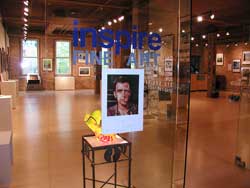 On Thursday, opening night, there was quite a large crowd in attendance. The gallery was pretty filled, and from what I understand, this was a larger room than the one from the London exhibit. Storm was seated at a table, talking to people, signing books and such, being his entertaining and charming self. I introduced my wife, Marcia, who jokingly commented that there was a striking resemblance between us, after seeing the picture that was taken outside the hotel a few days earlier, and wanted to know his whereabouts in February of 1959. Storm got a good chuckle out of this, and so did his son Bill who was standing just a few feet away. I asked Storm if he would sign my first edition of “Mind Over Matter” (which I ran out and bought the first day it came out, even though I had the flu), and he did by signing, “To my son (????) Storm Thorgerson, 2005.” We all got a huge laugh from this, and I thanked him once more.
On Thursday, opening night, there was quite a large crowd in attendance. The gallery was pretty filled, and from what I understand, this was a larger room than the one from the London exhibit. Storm was seated at a table, talking to people, signing books and such, being his entertaining and charming self. I introduced my wife, Marcia, who jokingly commented that there was a striking resemblance between us, after seeing the picture that was taken outside the hotel a few days earlier, and wanted to know his whereabouts in February of 1959. Storm got a good chuckle out of this, and so did his son Bill who was standing just a few feet away. I asked Storm if he would sign my first edition of “Mind Over Matter” (which I ran out and bought the first day it came out, even though I had the flu), and he did by signing, “To my son (????) Storm Thorgerson, 2005.” We all got a huge laugh from this, and I thanked him once more.
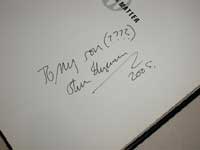 I pulled out the camera to take a few pictures but the damn memory card for the camera was back home in the computer again! I’m sure glad that I don’t do this for a living. Rupert promised to mail me some of the pictures he took opening night, so hopefully they will be added to A Fleeting Glimpse shortly.
I pulled out the camera to take a few pictures but the damn memory card for the camera was back home in the computer again! I’m sure glad that I don’t do this for a living. Rupert promised to mail me some of the pictures he took opening night, so hopefully they will be added to A Fleeting Glimpse shortly.
Nina set up a private interview for me on Friday, and Storm wanted to meet in the Signature Lounge, which is the restaurant located on the top of the Hancock Building on the 96th floor! I tried to forget that I get slight vertigo at these heights, and ignore the uneasiness I get from riding in shaky, rapidly ascending little boxes called elevators (or lifts, depending on which part of the world you’re reading this in).
I arrived at the Hancock a bit early (I’ll be damned if I was going to be late again), faced my anxiety, and held my breath during the short ride up, trying to ignore the fact that it was Friday the 13th. It was a pretty cloudy day but the view was still staggering. Storm arrived right on time, accompanied by Nina and Bill, all returning from the Frank Lloyd Wright tour in Oak Park. After checking out the view, we seated ourselves in a booth away from the windows. We placed our drink order with Tracy, our waitress, and after asking her a few questions, Storm officially kicked off our conversation
Storm: This lady’s worked here for 2 years. Can you imagine working this high up for 2 years?
Ron: No. I can’t imagine spending more than a few hours up here. I have slight vertigo.
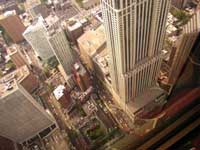 Storm: I have vertigo too. It is staggering (referring to the view). It’ll take about a month to get it out of my unconscious.
Storm: I have vertigo too. It is staggering (referring to the view). It’ll take about a month to get it out of my unconscious.
Ron: Maybe you’ll get some inspiration from the view?
Storm: (Pregnant pause… no response)
Ron: (laughing) Maybe not! Okay, my first question is this. Besides receiving a check from your clients, what’s your favorite part of the work process?
(Storm pauses to think about this and I don’t have the common sense to keep my mouth shut and wait for an answer. So I elaborate…)
Ron: Is it coming up with the concept…
Storm: Well if you’d only let me answer! I may have had a stroke but I’m not stupid.
Ron: Okay, okay, I’m sorry (laughing)
(Rupert Truman joins us proudly carrying the new camera he bought in Chicago)
Storm: Do you have the new camera here with you? Where’s the new baby?
(Rupert shows him the new purchase and we take a short break to order cocktails and appetizers before carrying on)
Storm: Okay. Where were we?
Ron: My question was, what is your favorite part of the creative process?
Storm: The favorite part is a difficult question. It’s slightly like the question, what’s your favorite cover? In a sense… impossible to say. It’s different for different jobs. I think the moment that an idea becomes crystallized is very exciting. When something works on a shoot, when you’re done with the physical work, when you look at your sculpture or your extallation (Storm’s term for an “outdoor installation”), your models or whatever it is…your props. They look great. Or your location or space. And that’s when you realize that you’re doing what you’re supposed to be doing. And then when you finish it off. The finished process of compositing, retouching if it’s required, and selection, although the selection of the material is very difficult sometimes.
(Our food and drinks arrive and we take a short break)
 Storm: So to recap, any stage of the work in progress can be the most exciting. Whether it’s the invention, the moment that an image or an idea comes clearly into mind. You never know when it is. It could be late at night in bed, or on the lou. It could be in the middle of a meal or in the middle of an argument. Or it could be some chance face of somebody, some sudden moment. When we actually set up to do a show, you know to realize the idea, like the pig over the power station. The moment that it all transpires or works, or in the case of the pig not work, that’s a fantastic moment.
Storm: So to recap, any stage of the work in progress can be the most exciting. Whether it’s the invention, the moment that an image or an idea comes clearly into mind. You never know when it is. It could be late at night in bed, or on the lou. It could be in the middle of a meal or in the middle of an argument. Or it could be some chance face of somebody, some sudden moment. When we actually set up to do a show, you know to realize the idea, like the pig over the power station. The moment that it all transpires or works, or in the case of the pig not work, that’s a fantastic moment.
Ron: What have been your most challenging projects?
Storm: The most challenging projects are either very physically really tricky, or dangerous. And the worst one was probably called “Transmissions” (Gentlemen Without Weapons – 1988), which is a line of telegraph poles sticking out across the countryside, because the big telegraph poles are real. And the farmer upon whose land we did this was a very miserable creature, who regrettably committed suicide later… not as a result of our shoot! But he was very difficult. After he let us on his land he kept raising his price. And then suddenly the day we were shooting, the day we erected the poles, unbelievable rains, so the place was just a quagmire. I was seriously dealing with bulldozers, tractors and pile drivers, because we put up 14 telegraph poles with seats on top to sit people, and it was a complete nightmare. So that’s when things go wrong, like it did for “A Momentary Lapse of Reason”, because we put all 700 beds on the beach and then it rained. And we couldn’t see the beds so we had to abandon it and do it all again. But that was scary, it wasn’t really a nightmare, but it was a bit of an effort. But “Transmissions” was a nightmare.
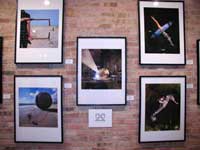 The difficult one was for a group Healing Sixes, of which there’s a picture of a man falling into a lake with a sort of round wooden ball on his shoulders. And I wanted the lake to be still, and I also wanted it to be a great place. So we decided to go to Utah, which was very expensive. And that was unbelievably tiring because the wind never let up and we never had still water. Every morning we got up at 4 o’clock in the morning in order to catch the early morning no-breezes, but there were always breezes, and we were so tired by the end of the shoot. And on the first time we went out, on the first day we went out, the driver drove the boat into the rocks, so I mean that was just unbelievable. And then we had the most scary plane ride back from Salt Lake City to Denver that I ever had in my life, and so that was really challenging.
The difficult one was for a group Healing Sixes, of which there’s a picture of a man falling into a lake with a sort of round wooden ball on his shoulders. And I wanted the lake to be still, and I also wanted it to be a great place. So we decided to go to Utah, which was very expensive. And that was unbelievably tiring because the wind never let up and we never had still water. Every morning we got up at 4 o’clock in the morning in order to catch the early morning no-breezes, but there were always breezes, and we were so tired by the end of the shoot. And on the first time we went out, on the first day we went out, the driver drove the boat into the rocks, so I mean that was just unbelievable. And then we had the most scary plane ride back from Salt Lake City to Denver that I ever had in my life, and so that was really challenging.
The other way a job is challenging I think, is when it’s pretty hard to make it work. Some things work easily. Relics was easy. You know they’re gonna work. Or you know they’re going to work but they may take a long time to work, but you know they’re going to. It’s the one’s that you don’t know if they’re going to work, now that’s very challenging. You get all your film back and you look at the results, and it’s not really convincing. So of course you have the problem of how are you going to explain it to the client? What are you going to say to yourself? What are you going to say to the band? This job is fucked up? We failed?
Then we were shooting one for the Cranbury’s. It’s called “Bury The Hatchet” and it was sort of this surveillance eye, this Big Brother eye floating in the sky, threatening a nude person. And I wanted to shoot it on red earth so I went to Monument Valley, and we found the perfect location and we were just shooting, and it was fantastic, and out of nowhere, really out of nowhere came a truck. It speeds to a halt and out jumps this Indian with hair down to his waist, shoulders like a brick shithouse, face as broad as a plank, he looked very mean. And we tried to put all our stuff away and have the naked man put his clothes on, because this was Navaho sacred land we’re talking about here. And his big hand, his huge hand came on the back of my shoulder, and I thought oh my God this is it, finally I’m going to be either arrested or beaten up and have all of my film and my props destroyed. And he said, “What’s your website? What’s your e-mail address?” Unbelievable! So we exchanged e-mail data, but at that moment I thought, “Oh no, this is totally fucked.” So there are situations when you think you’re not going to come back with the results, either because of the unseen difficulties, or there were difficulties inherent in the shot, trying to make it work as an effective piece. Those are the most challenging things, the most worrying things.
 Ron: I love looking at the rough conceptual sketches, especially in relationship with your finished work. Are there ever a required minimum number of images that are a contractual obligation from the band or the record company?
Ron: I love looking at the rough conceptual sketches, especially in relationship with your finished work. Are there ever a required minimum number of images that are a contractual obligation from the band or the record company?
Storm: No, no. Not contractual. I usually do somewhere between five and ten, mostly because I don’t know what’s best. And if I don’t know what’s best then I would to have a dialogue with the band so we can try to agree on one. Me, from a visual point of view, and them, from the record point of view. They know what’s more appropriate. I know what might look better. Hopefully that makes for a good combination. So these roughs are very figurative, they’re very direct, they’re not clever. They’re just simple drawings designed to show the content and usually the composition.
Ron: Much like a storyboard panel is used in animation or in filmmaking, just to set up blocking and give the idea of the image that you’re looking for.
Storm: It’s so that the band knows what they’re spending their money on.
Ron: You seem to like to shoot on locations like beaches and open spaces. What draws you to these locations?
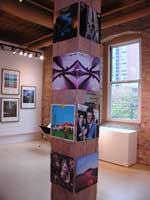 Storm: I think two things. Firstly is the largeness, because to me music is a large thing. You know an album is a big thing, whereas a CD cover is a small thing. So how do I get a big thing into a small thing? So the problem there is trying to get some dimension while allowing this restriction of physical size. The other thing is that landscapes are more like a sort of backdrop on which to paint something. So I take it as a backdrop image to put my actors, or my props, or my participants, whether they are animate or inanimate, it’s their stage. Or from a photographic point of view and a lighting point of view, that’s another reason, because it looks better. So usually we go to places where the light is good. Since we’re going to take a photograph this is crucial. So we often end up in America because we know the light will be good, and the locations are fantastic! We don’t do American towns, always countryside.
Storm: I think two things. Firstly is the largeness, because to me music is a large thing. You know an album is a big thing, whereas a CD cover is a small thing. So how do I get a big thing into a small thing? So the problem there is trying to get some dimension while allowing this restriction of physical size. The other thing is that landscapes are more like a sort of backdrop on which to paint something. So I take it as a backdrop image to put my actors, or my props, or my participants, whether they are animate or inanimate, it’s their stage. Or from a photographic point of view and a lighting point of view, that’s another reason, because it looks better. So usually we go to places where the light is good. Since we’re going to take a photograph this is crucial. So we often end up in America because we know the light will be good, and the locations are fantastic! We don’t do American towns, always countryside.
Ron: You’ve cited Munch, Dali, and even Maurice Sendak as being influences. Who else inspires you?
Storm: I don’t think that these are influences, they’re references. I believe that in Western culture there are so many influences that I can’t say that I’d put down one person, or one thing, or one artist, or even one kind of artist. I’ve been inspired by all sorts of artists. But then I’ve been inspired by women, I’ve been inspired by weather. I’m inspired by money and all these things inspire me.
Ron: You still obviously listen to the music and lyrics when you’re going to create an album cover…
Storm: Always, not still! No, no. By necessity, yes always. You know you say it as though I hadn’t done it before. My number one credo, number one policy, if there is a policy, is to listen to the music so much until you’re sick of it.
Ron: Have you ever heard an album or read lyrics that you didn’t like or just couldn’t relate to? And you don’t have to name names (laughing).
(Storm doesn’t have time to comment, as we take a break for dessert)
Ron: The next question is in regards to using multiple images for album covers. I can understand creating the different Division Bell covers for the numerous formats that it was released on (LP, CD, tape, minidisk), but how come albums like “AMLOR” and “Wish You Were Here” have alternate covers.
Storm: (shrugs, and gives the answer I least expected to hear from a man who retains such precise control over every aspect of production). Whim.
Ron: Whim? So like with “Lapse”, the guy’s either looking in the mirror or breaking a stick?
Storm: Whim
Ron: And “Wish You Were Here” has…
Storm: A different burning shot.
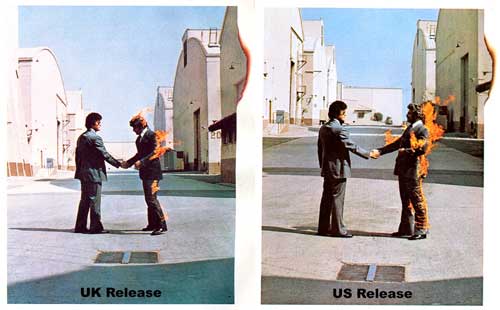
Ron: I always preferred the US version myself. I don’t know if it’s because I grew up with it and I’m used to it, or I like it because it’s more symmetrical, where both men are standing erect. And the fire is much better on the US cover. And now the new CD releases feature only the UK cover with the burning man leaning, so the US image will eventually be eventually phased out for good. So these were whims? Nothing to do with the record companies getting the hardcore collectors to buy each version of the album?
Storm: (seriously) Why would you do that? No, it’s whim. It’s sometimes because we can’t make up our minds which one we like better, so we use them both. Well we like them both, so we use them both. It’s also sometimes to distinguish between which is American product and which is European product, but not particular. Mostly whim.
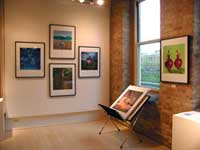 Ron: Okay. The concept for the Ragga cover was revisited for the Pink Floyd back catalogue campaign. The photographing of painted faces onto bald heads from above. How do you feel about re-exploring…
Ron: Okay. The concept for the Ragga cover was revisited for the Pink Floyd back catalogue campaign. The photographing of painted faces onto bald heads from above. How do you feel about re-exploring…
Storm: As a movie, right?
Ron: Yes, the commercial. How do you feel about re-exploring old concepts like this and repackaging ideas like “Dark Side of the Moon” for each milestone?
Storm: I feel fine because it’s my work so if I want to rework it I can. It’s an old tradition. Cézanne painted like twenty-seven versions of the same hill, Van Gough did nine versions of sunflowers, and Hiroshi… was it Hiroshi? What was the name of the man that painted that wave?
Ron: Oh I know who you’re talking about. The one that was on Nick’s drum kit for years. He did several versions of that?
Storm: He did ninety-seven versions of that!
Ron: (laughing) Okay
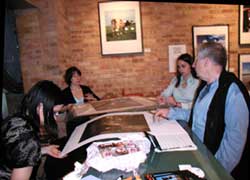 Storm: So it’s an old tradition. I also think that, you know “DSotM” … I’ve done it three different ways now, and when I did it the second time it was better than the first time, and when I did it recently for the thirtieth anniversary I thought that was the best of all. So I enjoyed and liked it when I did it again. (Storm gets playfully defensive here) Which I feel fine about reworking Ron, how do you feel about it?
Storm: So it’s an old tradition. I also think that, you know “DSotM” … I’ve done it three different ways now, and when I did it the second time it was better than the first time, and when I did it recently for the thirtieth anniversary I thought that was the best of all. So I enjoyed and liked it when I did it again. (Storm gets playfully defensive here) Which I feel fine about reworking Ron, how do you feel about it?
Ron: (laughing) I love it. I’m all for it Storm! Okay, let’s explore the digital age if you will. Digital photography and image manipulation with programs like Photoshop are very accessible and widely used these days. Obviously nothing will replace the human imagination and creativity, but there’s no denying that computers, or as you called it on your website, the “dreaded computer”, now play a significant role in the creative process.
Storm: No it doesn’t.
Ron: Well instead of doing multiple exposures and matte work in darkrooms, now I’d imagine that most of your images are composited and retouched on computers… in the instances when it needs to be done. Or am I just wrong in assuming this?
Storm: I don’t think it’s wrong, but I think that computers don’t have anything to do with the creative process. The creative process is done between thinking about it and doing the drawings, talking to your colleagues and doing some more drawings, letting drawings determine future drawings, then talking some more. And then draw again. A computer isn’t really involved in the creative process at all. It’s involved in the finished product. It’s involved in the artwork, but only where suitable
Ron: So you don’t feel that digital manipulation is a creative process?
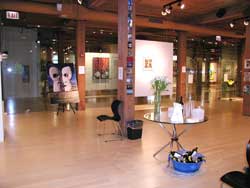 Storm: Not for me, no.
Storm: Not for me, no.
Ron: It’s more of just a tool to get the job done, helping you realize the final product.
Storm: I think the computer in my head is bigger than the computer on my desk.
Ron: Agreed!
Storm: But obviously some people find it a tool that they can use in creativity. Which is fine, I don’t have an issue with it, it’s just not for me.
Ron: But do you feel that some of the work that you’ve created in the digital age would have been impossible to do before hand. Some of the images you’ve created would have been very hard to do.
Storm: Hard, yes, but not impossible. You know, one of my very favorite pieces, which I still like, in fact I’ll name you two that I still like. Because I’ve been doing this a long time now, probably too long, some people will say. Time to get him out of here. But, when you’ve done it for thirty years, I’ll name you a couple of what I find are durable pieces, pieces that are perfect to me. One is for a band called The Nice from 1970 called “Elegy.”
Ron: Yes, the red balls on the sand dunes.
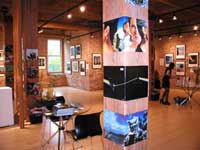 Storm: And there was no manipulation, no computer. There’s no compositing, it’s just a piece of land art that we did there in another time. Nothing is rearranged or altered. It’s just a photo. Another one is “In Through The Out Door” for Led Zeppelin done about five years later. Now that is a sepia print done in the old tried and tested method with a mask made of acetate in the shape of a brushstroke, which is placed over the paper as it’s exposed, so it has less exposure. The whole thing is then sepia’d, but the bit with the brushstroke is less sepia’d because it has less detail on it anyway, because it’s being held back by the mask, and then it’s hand painted.
Storm: And there was no manipulation, no computer. There’s no compositing, it’s just a piece of land art that we did there in another time. Nothing is rearranged or altered. It’s just a photo. Another one is “In Through The Out Door” for Led Zeppelin done about five years later. Now that is a sepia print done in the old tried and tested method with a mask made of acetate in the shape of a brushstroke, which is placed over the paper as it’s exposed, so it has less exposure. The whole thing is then sepia’d, but the bit with the brushstroke is less sepia’d because it has less detail on it anyway, because it’s being held back by the mask, and then it’s hand painted.
The image is altered in that fashion, so it has color but it’s just brown. The color is quite slight. It’s a favorite piece of artwork done in the old tried technique. Computers don’t have any relationship to either of these two pieces, so I don’t think the computer in my realm, in my domain, in my funny mind, I don’t think the computer has much to say creatively. I think it has a lot to say for artwork. It has a lot to say especially for fonts. I mean you’d have to ask a typographer but it has revolutionized typography, and the use and spacing of type fonts, and the manipulation of fonts, well I think that’s a different ball game. But it’s not my ballgame.
I respect it greatly but it’s not mine. In terms of Photoshop or anything else, these are tools, as I would think Photoshop was meant to be. But like any good tool, you know it could be a knife, it could be a paintbrush, a tool to some extent imposes it’s own limitations and its own aspects on your artwork. So therefore you can’t use a computer to make art. So the answer is Digital Schmigital!
Ron: Digital Schmigital. I like that. It could be the name of a book of all your pre-digital age work.
Storm: It’s called “Walk Away Rene.”
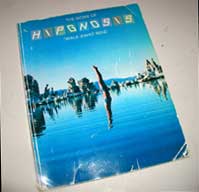 Ron: And I have my three-decade old copy with me, which I’d like to show you in a few minutes. You seem to like working big and in life-size scale; the Division Bell statues, the giant ball of rope on the beach on the Phish cover, the crib for the Catherine Wheel, the giant Floyd chair. It’s confounding to me that something like the giant eye on “Bury the Hatchet” is a fiberglass model. Now come on! Why not just create this in Photoshop or build a CG model where you can control the lighting and compositing?
Ron: And I have my three-decade old copy with me, which I’d like to show you in a few minutes. You seem to like working big and in life-size scale; the Division Bell statues, the giant ball of rope on the beach on the Phish cover, the crib for the Catherine Wheel, the giant Floyd chair. It’s confounding to me that something like the giant eye on “Bury the Hatchet” is a fiberglass model. Now come on! Why not just create this in Photoshop or build a CG model where you can control the lighting and compositing?
Storm: It won’t look the same. It never looks the same. It would look painted. A prop looks like a prop. A sculpture looks like a sculpture.
Ron: That’s one of the things that really blew me away when I was exploring your website. When you see that eye, I guess you just assume that it’s digitally retouched. Maybe this works to your advantage in this digital age. People might look at your work and assume that there was some digital manipulation, just as airbrushing previously cleaned up photographs.
Storm: I don’t really bother with that. I think that people either find it interesting or don’t. Only people like us ask that. People like you ask that. I don’t think your average listener, person, or customer, or viewer thinks like that. I think they just look at an image, and if they bother to look at it for more than a minute or two, they will either find it interesting or not. I don’t think that they care very much about the details, either how it’s done or where it’s done. They may ask later, if they get to like it a lot, then they may ask how it was done. The beds on the beach actually could not be done by a computer, because you could never get the perspective of each bed and the bedding of each bed. So I’m always surprised when people ask me whether it was done on a computer because they must be idiots.
Ron: How about the Deepest Blue cover, “Late September”? Is that a “complete” shot or is it a composite?
Storm: Well the wave is a wave, the girl is a girl, a very nice girl too. A very nice wave, a very nice location, shot in South Africa.
Ron: Cape Town
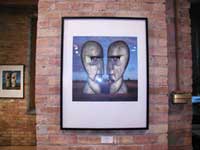 Storm: And my son is a surfer, and surfers know where the big waves are. And he was right, there they were. At that particular moment, or in Costa Rica at another moment. The surfers, it’s their business isn’t it really? So my son’s a surfer and he knows where to find the waves. And it worked out very well. Do you mean have we embroidered a little? Yes we’ve embroidered just a little, because it’s a piece of imagination. Rather badly timed considering the tsunami, the Asian tsunami. I don’t know if that’s prescient or… what’s the word I want?
Storm: And my son is a surfer, and surfers know where the big waves are. And he was right, there they were. At that particular moment, or in Costa Rica at another moment. The surfers, it’s their business isn’t it really? So my son’s a surfer and he knows where to find the waves. And it worked out very well. Do you mean have we embroidered a little? Yes we’ve embroidered just a little, because it’s a piece of imagination. Rather badly timed considering the tsunami, the Asian tsunami. I don’t know if that’s prescient or… what’s the word I want?
Ron: Prophetic?
Storm: Prophetic or prescient, yeah. But it was prophetic obviously. It came out four months before the wave came out. A bit uncomfortable in some ways, but it was actually thought up four years ago. And we adapted to fit an old friend reworked. I quite like it.
Ron: It’s a beautiful image especially the high quality print that’s being displayed in the gallery.
Storm: Oh it’s much nicer seeing it with the proper colors. And I think that the body painting is very nice on the lady. The lady is very nice too, she’s called Laura.
Ron: Now how about a few Pink Floyd related questions? How has your working relationship with David Gilmour and the Floyd camp changed over the years?
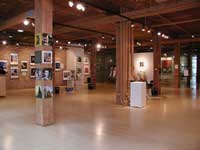 Storm: It really hasn’t changed very much; other than of course we all get older and more crabby. Also, of course, since their manager died, there seems to be a hiatus of output, so in a sense there’s not much for me to do.
Storm: It really hasn’t changed very much; other than of course we all get older and more crabby. Also, of course, since their manager died, there seems to be a hiatus of output, so in a sense there’s not much for me to do.
Ron: Well they’ve never been that prolific
Storm: Well they were prolific in the seventies. Roger of course doesn’t employ me directly. He does indirectly.
Ron: Would you care to elaborate on that?
Storm: Well… not particularly.
Ron: Okay (I start laughing at this).
Storm: It’s an old story. You know Roger has a certain view and a fixed mind about certain things and he decided that after “The Wall” that he really didn’t want me to work with him anymore. Which is kind of all right… it’s a pity, but it’s all right. But I don’t think there’s any particular reason. Whatever the particular reason it’s gone by now.
Ron: I’m not a big fan of his solo career’s album cover art.
Storm: Me neither
Ron: I understand that you presented the band with seven pieces of conceptual art for “Dark Side of the Moon” in which they picked the prism design almost immediately. Do you remember what some of the other design options were?
Storm: Yes one was a surfer. A Silver Surfer.
Ron: Like from Marvel Comics?
Storm: Yes. I can’t think what the others were. People ask me that question and it’s a pity they’re lost. I wish I hadn’t lost them.
Ron: We briefly talked about working in film. I teach a History of animation class and we watch and discuss the German abstractionist films from the early 1920’s. Artists like Walter Ruttman, Hans Richter and Oscar Fischinger. They were all painters and sculptors who wanted to use this new medium of film to add the element of time to their work. And I love the idea of adding “time” to some of your images and seeing them move. Specifically, “High Hopes” is a brilliant film, which obviously contains some of your signature imagery.
Storm: Well of course it’s my signature imagery, it’s my film. Who else’s signature would it be?
Ron: Of course, but in “High Hopes” especially. The images of the long flowing cape, the businessmen with the long, stilted legs.
Storm: I like those images as well. What’s your question?
Ron: You mentioned that you had an interest in making a film or directing a feature. Did you ever consider making an independent short that did not necessarily have a traditional linear narrative, just a series of moving images?
Storm: Not really, no. In terms of film, I would like to make a feature film. I have a script, a story. So I would like to do that although my health prevents me, apart from the fact that I haven’t got the money for it. I think I like to solve problems. I like problem solving. And so in terms of doing a video or a cover, they have a problem. Like what’s it gonna be? So I have to come up with the solution. And if I was going to write my own film… well, I’m not a scriptwriter so I can’t. But I have a script written by a friend of mine that I commissioned, which I like very much. I wrote a short film once, but that was so long ago, about two drunks, but unfortunately it was very… it was based on a concept that turned out to be identical to “Blair Witch Project.” So I had to cancel that.
Ron: Getting back to “High Hopes,” when you approach making a video like that, is it storyboarded? Are your images storyboarded linearly so you know in advance which image will accompany the corresponding parts of the song?
Storm: Yes. It’s storyboarded mostly so the band can see it. In the case with the Floyd they have to see it because they’re paying for it and, not unreasonably, they want to know what it is. But “High Hopes” is an amalgamation of images… it’s not really linear and it’s not really a story. It’s really a collection of images that represent the resonances of youthful memories that Dave has about Cambridge, which is our hometown. So the long scarves, the big cape, are all references to the students of Cambridge. Cambridge being a university town. The stilted men, for example, are related to being a child and relating to grownups who are just taller by definition, because you’re a child. So there are all these references to that, that idea of what was it like to be a child, and specifically to Cambridge. But it’s not a story; it’s not a linear thing.
Ron: You’re involved in the editing process, right to the end of the completion of these videos, right? Some of the shots seem to work so well together. There’s an image of some people sitting in a circle that dissolves to the image of a spinning wheel. Are things like this predetermined or is all of this worked out while editing?
Storm: It’s predetermined to a degree. It was a thought, a theme. Sometimes it worked sometimes it didn’t. There’s a certain circularity to the song, and to the memories that Dave has, and where he’d come from and where he’d got to. So there’s a certain circularity, life’s rich cycle if it were.
Ron: It must be nice to be able to relate to Dave on a level like that because you both must share the same childhood memories having grown up in the same place and time.
Storm: It is, but we’re very different. It’s been great working with the Floyd, but it’s also great working with Peter Gabriel, it’s great working with Mars Volta among others. But obviously the Floyd is the premier relationship because it’s the longest, because they’re a very big, high profile band. They’re a very good band. You know, there’s Genesis, Led Zeppelin, Muse, Alan Parsons, Catherine Wheel, these are all, what I consider to be, productive relationships. I mean, together we did a lot of work, and by in large, it worked well. The best album covers to me are those that are a synthesis between the musician and the designer. The musicians need to feel that it relates, that it is personal, that it is appropriate. But you need the designer to visualize, to present that appropriateness in a better light, in a more effective way because he’s more visually minded. So, to me, design is always arranged between client and designer, not a design problem. So, if a design is bad, it may be bad because the designer is crap, but it may also be crap because the client is crap. And this often happens in advertising where the clients are usually crap. Are we almost done here Ron, I’m fading a bit.
Ron: Just a couple more Storm. I really am curious about the status of the PULSE DVD. Is your part done? Are you still working on it? Did you design a new cover for it? The one where there are the two PULSE “eyes” propped on top of each other.
Storm: (eyes widening). Where did you see that?
Ron: Um… let’s just say I’ve seen it (not wanting to reveal that’s it’s right here on A Fleeting Glimpse).
Storm: Not exactly. Like that, but not exactly.
Ron: I love the films you did for the Division Bell tour. Will viewers be able to access them independently on the DVD?
Storm: Yes. Dave wanted to included them as independent extras, but I didn’t want that. I wanted them to be accessed only during the concert because that’s how I though they should be viewed, as an integral part of the concert experience.
Ron: You’ve dabbled in animation a few times. The concert film for “Great Gig in the Sky,” the Flash piece for the “Wish You Were Here” anniversary. Any comments on working in animation?
Storm: I can’t draw. I can’t draw, Ron.
Ron: Okay, but you’re still a conceptualist, designer and director. You don’t actually need to know how to “draw” anymore to express yourself in this medium.
Storm: I could, but I don’t think it’s very likely. My mind is heavily involved in photography and film. I think it would be unlikely to reappear in animation. I doubt it. But I don’t have anything against it. I don’t have a problem with animation. I don’t have a problem with gay people. But I don’t think I’m going to be gay. I mean if you suggest that I try being gay, you know…
Ron: No, no, I’m not going that road.
Storm: I don’t particularly want to try it, but I don’t have anything against them as it were. And likewise, I don’t have anything against animation. (brief pause). Now, gay animation I really can’t stand!
Ron: (laughing) Okay fair enough. Thanks for taking the time for this conversation, Storm. But before we part, I want to show you something that I’ve been saving for last.
(I pull out my beat up old copy of “Walk Away Rene”).
Ron: I’ve had this book for four decades and I still love to look through it. Would you mind giving it your Storm Hancock?
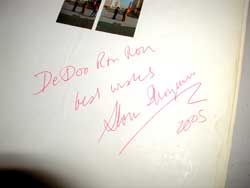 (Well…. I thought that it was a clever pun, being in the Hancock building and all. And of course Storm obliges, paying homage to another old 60’s tune by signing “DeDoo Ron Ron. Best Wishes, Storm Thorgerson 2005)
(Well…. I thought that it was a clever pun, being in the Hancock building and all. And of course Storm obliges, paying homage to another old 60’s tune by signing “DeDoo Ron Ron. Best Wishes, Storm Thorgerson 2005)
And so our conversation comes to close. Storm and company need to head to the gallery to greet the fans from a local radio station promoting the exhibit. I do get to pose one last question on the ride down from the 96th floor, distracting me from my uneasiness of being in one of these rapidly plunging, shaky boxes. I asked Storm if any albums besides AMLOR ever had to be recalled for a printing error. He didn’t seem to know what I was talking about, so I pulled the recalled album out of my bag and showed it to him.
Ron: (sarcastically) Look what they did to your beautiful work Storm.
Storm: Hmm. Don’t know anything about this.
Ron: Well, it’s a collector’s item now so you’ll have to give it back.
I arrived back at the gallery, and having the right combination of batteries and memory card, was finally able to take some pictures. I also bought the Nevada Series, a set of 8 classic Storm prints for a very reasonable price. These must have sold quite quickly because I got the last set. I guess things have been selling pretty well in general, as I overheard Liz talking to Storm about some of the sales.
I said goodbye to Nina as she headed off to the airport. I then asked Rupert if I could take a picture of him, asking him to choose one of his photos for the backdrop. He happily agreed, wearing the smile that never left his face in all the time I spent with him. I wished him a safe and pleasant trip across the country, and then said farewell to Storm. I humbly thanked him for his time and consideration, and wished him the best, and a continued recovery. I left the gallery with quite a buzz from the day, letting the sounds of “The Division Bell” carry me home, as a Storm passed over our heads.
We are very pleased to be able to showcase a few of the pictures taken by Rupert Truman at Storm’s Chicago Exhibition 6 May – 4 June 2005.
Rupert works very closely with Storm, and was the camerman assigned to get some shots of the Chicago show.
We are indebted to Rupert for allowing us the use of his images.
The above images were provided by Seth from the Floydian Propulsion Project. Take yourself to Floydhead.com and see a larger exhibition with stacks more photos!

